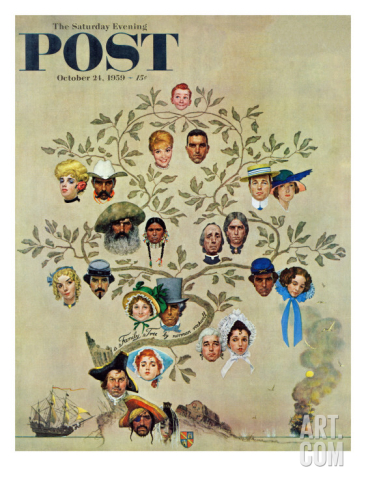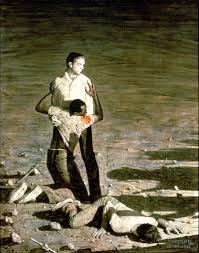This weekend I saw a special exhibit of Norman Rockwell’s work here in Nashville . I had heard it was great, and I wasn’t disappointed. But I came in with very different impressions of Rockwell than I had when I entered.
Going in, I pictured Rockwell’s work as rather sentimentalized, nostalgic, idealized images of Americana. It’s how he’s stereotypically known, largely because of his nearly 50 years of illustrating over 300 covers for the Saturday Evening Post (1916-1963). There were plenty of those images in the exhibit, of course—fresh-faced cherubic children in the scenes of small-town America, folksy-shucksy renditions of everyday life. And those are stunning in their own right; his style is captivating, especially his ability to convey the emotion and dynamism of a story in a single scene.
By the time I left, however, I’d seen a different side of Rockwell, one which emerged more in the later part of his career. It was the part of him that cared a lot about issues like poverty and civil rights, issues he wasn’t really free to explore on the cover of the Saturday Evening Post. In fact, the Post wouldn’t allow black people to be depicted unless they were in service industry roles. Maybe that shouldn’t surprise me, but it makes me realize that I had been assuming Rockwell’s subject matter was reflective of his own preoccupations, rather than reflective of the policies and procedures of the larger system to which he was beholden.
I noticed that toward the end of his time at the Post, he was exploring more diverse and complicated narratives than those that dominated his work in the 20s, 30s, and 40s. One of my favorites was this 1959 cover, “Family Tree,” which evoked the complexity of America’s family tree.
In 1961 his “Golden Rule” again pushed the envelope for the magazine’s standards, depicting non-white faces as part of American heritage and counting among those to whom we should do as we would want done unto ourselves.
In 1963 he stopped illustrating for the Post and over the next several years produced a number of pieces in Look magazine, where he was free to depict a wider swath of American life. I wonder how long that impulse had been developing in him. It was no doubt shaped in part by his relationship with the psychoanalyst Erik Erikson, who supported Rockwell through bouts of depression. It may have been Erikson’s connection to Robert Coles, the child psychiatrist who wrote about the experiences of 6-year old Ruby Bridges and other black children who attended newly desegregated schools, that prompted Rockwell to produce “The Problem We All Live With” in 1963.
 The Problem We All Live With, 1963
The Problem We All Live With, 1963
Powerful. So is “New Kids in the Neighborhood,” 1967…
 New Kids in the Neighborhood, 1967
New Kids in the Neighborhood, 1967
…as was the image of “Southern Justice” Rockwell produced based on the story of three young men murdered for their civil rights work:
Not surprisingly, his Saturday Evening Post fans had mixed reactions to the new chapter in his work, and I’m sure many wished he would just stick to the less troubling images of white children with their puppies and grandfathers.
I think of budding artists today, who are figuring out their style, their beliefs, their values, and, not unimportantly, how they can make some money at their art. Rockwell made a hefty amount of cash for what he produced, but he didn’t have—or push for—the kind of freedom to express his perspectives in his work until late in his career. He was successful early on—only 22 years old when his first Post cover ran—but it took decades to emerge from the constraints that tempered his risk-taking. I wish it hadn’t taken that long, for Rockwell or for America, to lift up a bigger and more honest picture of “everyday life.”



